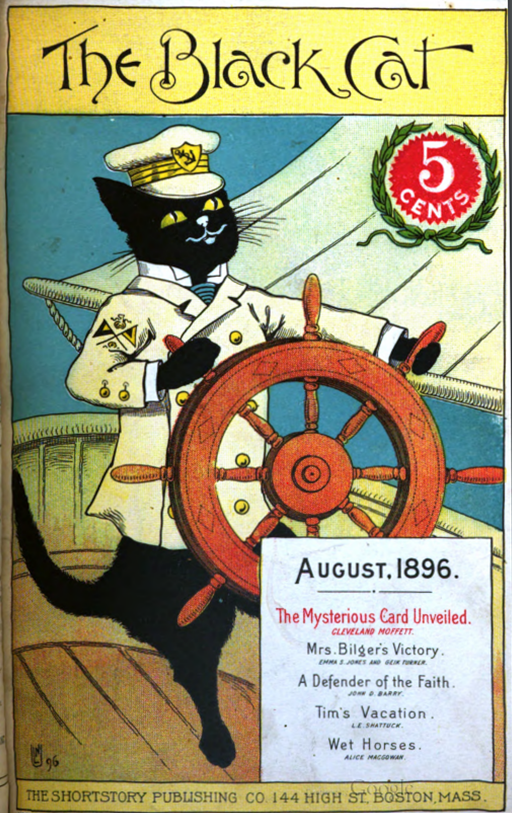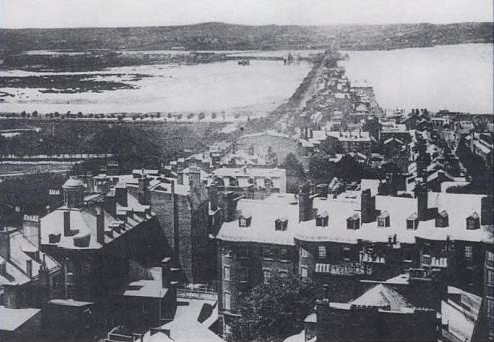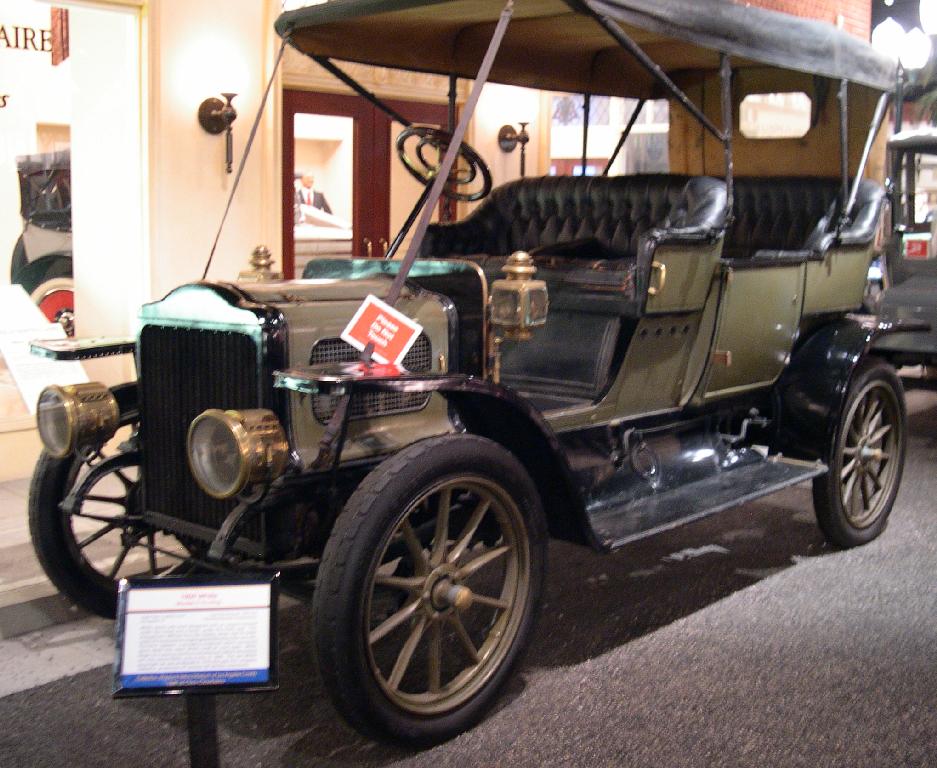|
The Black Cat (US Magazine)
''The Black Cat'' was an American fiction magazine launched in 1895 by Herman Umbstaetter, initially published in Boston, Massachusetts. It published only short stories, and had a reputation for originality and for encouraging new writers. Umbstaetter’s editorial approach was unusual in several ways: the cover price was low, at five cents; he paid on merit, not on story length; and he was willing to buy stories by new authors rather than insisting on well-known names. He frequently ran story contests to attract amateur writers. The magazine was immediately successful, and its circulation was boosted by the appearance in an early issue of “The Mysterious Card”, by Cleveland Moffett, which was so popular that two print runs of the issue it appeared in sold out. Many well-known writers appeared in its pages. Two of the best-known were Jack London, whose 1899 story “ A Thousand Deaths” sold just as he was about to give up attempting to become a writer, and Henry Mille ... [...More Info...] [...Related Items...] OR: [Wikipedia] [Google] [Baidu] |
The Black Cat 1896 August
''The'' () is a grammatical Article (grammar), article in English language, English, denoting persons or things already mentioned, under discussion, implied or otherwise presumed familiar to listeners, readers, or speakers. It is the definite article in English. ''The'' is the Most common words in English, most frequently used word in the English language; studies and analyses of texts have found it to account for seven percent of all printed English-language words. It is derived from gendered articles in Old English which combined in Middle English and now has a single form used with pronouns of any gender. The word can be used with both singular and plural nouns, and with a noun that starts with any letter. This is different from many other languages, which have different forms of the definite article for different genders or numbers. Pronunciation In most dialects, "the" is pronounced as (with the voiced dental fricative followed by a schwa) when followed by a consonant s ... [...More Info...] [...Related Items...] OR: [Wikipedia] [Google] [Baidu] |
The Chap-Book
''The Chap-Book'' was an American literary magazine between 1894 and 1898. It is often classified as one of the first "little magazines" of the 1890s.(1982). ''The Chap-Book: A Journal of American Intellectual Life in the 1890s'' (Ann Arbor, MI: UMI Research Press) by Wendy Clauson Schlereth The first edition of ''The Chap-Book'' was dated 15 May 1894. Its editor was Herbert Stuart Stone and it was published by Stone and Kimball. It was originally published in Cambridge, Massachusetts, but after six months moved to Chicago, Illinois when Stone and Kimball relocated to Chicago. ''The Chap-Book'' was published twice monthly. Its final issue was issued on 1 July 1898. After this, it merged with ''The Dial''. Contributors to ''The Chap-Book'' included Henry James, Hamlin Garland, Eugene Field, Bliss Carman, Julian Hawthorne, Max Beerbohm, W. E. Henley, H. G. Wells Herbert George Wells [...More Info...] [...Related Items...] OR: [Wikipedia] [Google] [Baidu] |
Marguerite Clayton
Marguerite Clayton (born Margaret Fitzgerald; April 12, 1891 – December 20, 1968) was an American actress of the silent era. She appeared in more than 170 films between 1909 and 1928, many of which were westerns with Broncho Billy Anderson and Harry Carey. Biography Margaret Fitzgerald was born in Ogden, Utah, on April 12, 1891 and attended St. Mary's Academy in Salt Lake City, Utah. He father was a mining engineer. In 1909, Clayton made her first films, ''A Mexican's Gratitude'' and ''The Heart of a Cowboy'', with Anderson. Her film career ended in 1928. Her employers included Essanay. Clayton died in Los Angeles, California, in a road accident. She was buried with her husband Major General Victor Bertrandias in Arlington National Cemetery. Selected filmography * ''His Regeneration'' (1915) * ''The Prince of Graustark'' (1916) * '' Hit-The-Trail Holliday'' (1918) * '' Inside the Lines'' (1918) * ''The New Moon'' (1919) * ''Bride 13'' (1920) * '' The Pleasure Seekers'' ... [...More Info...] [...Related Items...] OR: [Wikipedia] [Google] [Baidu] |
Richard Travers
Richard Travers (15 April 1885 – 20 April 1935) was a Canadian film actor of the silent era. He appeared in more than 140 films between 1912 and 1930. Selected filmography *''Homespun'' (1913) short for Essanay *''The Ambition of the Baron'' (1915) *''The Romance of an American Duchess'' (1915) *''The White Sister'' (1915) *''Captain Jinks of the Horse Marines'' (1916) * '' The Phantom Buccaneer'' (1916) * ''The Trufflers'' (1917) *''The White Moll'' (1920) *''The Single Track'' (1921) * ''The Rider of the King Log'' (1921) *''The Mountain Woman'' (1922) * ''Dawn of Revenge'' (1922) * ''Notoriety'' (1922) *''The Acquittal'' (1923) *'' The Broad Road'' (1923) *''Mary of the Movies'' (1923) – cameo *'' The Rendezvous'' (1923) * ''The House of Youth'' (1924) *'' Head Winds'' (1925) * '' The Truthful Sex'' (1926) * ''The Dangerous Dude'' (1926) * ''The Still Alarm'' (1926) *'' Lightnin''' (1925) *'' Melting Millions'' (1927) *''The Man Without a Face'' (1928) *'' The Black ... [...More Info...] [...Related Items...] OR: [Wikipedia] [Google] [Baidu] |
Metropolitan Magazine (New York City)
''Metropolitan'' was an American magazine, published monthly from 1895 to 1925 in New York City. Former U.S. President Theodore Roosevelt was editor of the magazine during World War I when it focused on politics and literature. It was sometimes named, or called, ''Metropolitan Magazine'' or ''The Metropolitan'', and its final issues were published as ''Macfadden's Fiction-Lover's Magazine''. Publication history ''Metropolitan Magazine'' began in 1895 as a "naughty picture magazine selling sex sationalism" in its earliest issues. In 1897 the ''Metropolitan'' featured suggestive photos of Nellie Melba the opera singer and of Yvette Guilbert reclined in her boudoir, which was very risque for the time. John Brisben Walker was its first editor and publisher. In 1898, the magazine built a more sophisticated reputation as a magazine for theater-goers in New York featuring writings by Kipling and Conrad. In 1902, the magazine was sold along with ''The Daily Telegraph'' for $100,000 ... [...More Info...] [...Related Items...] OR: [Wikipedia] [Google] [Baidu] |
Pulp Magazine
Pulp magazines (also referred to as "the pulps") were inexpensive fiction magazines that were published from 1896 to the late 1950s. The term "pulp" derives from the cheap wood pulp paper on which the magazines were printed. In contrast, magazines printed on higher-quality paper were called "glossies" or "slicks". The typical pulp magazine had 128 pages; it was wide by high, and thick, with ragged, untrimmed edges. The pulps gave rise to the term pulp fiction in reference to run-of-the-mill, low-quality literature. Pulps were the successors to the penny dreadfuls, dime novels, and short-fiction magazines of the 19th century. Although many respected writers wrote for pulps, the magazines were best known for their lurid, exploitative, and sensational subject matter, even though this was but a small part of what existed in the pulps. Successors of pulps include paperback books, digest magazines, and men's adventure magazines. Modern superhero comic books are sometimes considere ... [...More Info...] [...Related Items...] OR: [Wikipedia] [Google] [Baidu] |
Back Bay, Boston
Back Bay is an officially recognized neighborhood of Boston, Massachusetts, built on reclaimed land in the Charles River basin. Construction began in 1859, as the demand for luxury housing exceeded the availability in the city at the time, and the area was fully built by around 1900. It is most famous for its rows of Victorian brownstone homes—considered one of the best preserved examples of 19th-century urban design in the United States—as well as numerous architecturally significant individual buildings, and cultural institutions such as the Boston Public Library, and Boston Architectural College. Initially conceived as a residential-only area, commercial buildings were permitted from around 1890, and Back Bay now features many office buildings, including the John Hancock Tower, Boston's tallest skyscraper. It is also considered a fashionable shopping destination (especially Newbury and Boylston Streets, and the adjacent Prudential Center and Copley Place malls) and home to ... [...More Info...] [...Related Items...] OR: [Wikipedia] [Google] [Baidu] |
The Journalist (newspaper)
''The Journalist'' (1884 - 1907) was the first successful American trade newspaper covering journalism. It was founded as ''The Journalist: A Magazine for All Who Read and Write'' by Leander Richardson and Charles Alfred Byrne and published weekly, commencing with its first issue on March 22, 1884.Newspaperdom Los Angeles Herald, Volume 25, Number 218, 6 May 1898Covering America: A Narrative History of a Nation's Journalism p. 155Lee, Alfred McClung [...More Info...] [...Related Items...] OR: [Wikipedia] [Google] [Baidu] |
Steam Car
A steam car is a car (automobile) propelled by a steam engine. A steam engine is an external combustion engine (ECE) in which the fuel is combusted outside of the engine, unlike an internal combustion engine (ICE) in which fuel is combusted inside the engine. ECEs have a lower thermal efficiency, but carbon monoxide production is more readily regulated. Steam-powered automobiles were popular with early buyers. Steam was safe, reliable, and familiar. People had decades of experience with it in trains and boats, and even in experimental road vehicles. However, early steam cars required constant care and attention—and up to 30 minutes to start. Automated quick-firing boilers solved these problems, but not before more efficient gasoline engines dominated the market and made steam cars obsolete. The first experimental steam-powered cars were built in the 18th and 19th centuries, but it was not until after Richard Trevithick had developed the use of high-pressure steam around 1800 ... [...More Info...] [...Related Items...] OR: [Wikipedia] [Google] [Baidu] |
Raymond And Whitcomb
Raymond is a male given name. It was borrowed into English from French (older French spellings were Reimund and Raimund (other), Raimund, whereas the modern English and French spellings are identical). It originated as the Germanic languages, Germanic ᚱᚨᚷᛁᚾᛗᚢᚾᛞ (''Raginmund'') or ᚱᛖᚷᛁᚾᛗᚢᚾᛞ (''Reginmund''). ''Ragin'' (Gothic language, Gothic) and ''regin'' (Old German) meant "counsel". The Old High German ''mund'' originally meant "hand", but came to mean "protection". This etymology suggests that the name originated in the Early Middle Ages, possibly from Latin. Alternatively, the name can also be derived from Germanic Hraidmund, the first element being ''Hraid'', possibly meaning "fame" (compare ''Hrod'', found in names such as Robert, Roderick, Rudolph (name), Rudolph, Roland (name), Roland, Rodney (name), Rodney and Roger) and ''mund'' meaning "protector". Despite the German and French origins of the English name, some of its earl ... [...More Info...] [...Related Items...] OR: [Wikipedia] [Google] [Baidu] |
American News Company
American News Company (ANC) was a magazine, newspaper, book, and comic book distribution company founded in 1864 by Sinclair Tousey, which dominated the distribution market in the last quarter of the 19th century and the first half of the 20th century. The company's abrupt 1957 demise caused a huge shakeup in the publishing industry, forcing many magazine, comic book, and paperback publishers out of business. The magazine and book operations of A360media have been reorganized and chartered as American News Company LLC. but has no connection to the defunct American News Company which folded in 1957. Early years The American News Company had its roots in two New York City newspaper and periodical wholesaling firms: Sinclair Tousey's company on Nassau St., and the firm Dexter, Hamilton & Co. at 22 Ann St. These were the two largest news and periodical wholesalers in New York City at the time of their merger on Feb. 1, 1864, when American News Company was formed. The seven original p ... [...More Info...] [...Related Items...] OR: [Wikipedia] [Google] [Baidu] |
Lithography
Lithography () is a planographic method of printing originally based on the immiscibility of oil and water. The printing is from a stone (lithographic limestone) or a metal plate with a smooth surface. It was invented in 1796 by the German author and actor Alois Senefelder and was initially used mostly for musical scores and maps.Meggs, Philip B. A History of Graphic Design. (1998) John Wiley & Sons, Inc. p 146 Carter, Rob, Ben Day, Philip Meggs. Typographic Design: Form and Communication, Third Edition. (2002) John Wiley & Sons, Inc. p 11 Lithography can be used to print text or images onto paper or other suitable material. A lithograph is something printed by lithography, but this term is only used for fine art prints and some other, mostly older, types of printed matter, not for those made by modern commercial lithography. Originally, the image to be printed was drawn with a greasy substance, such as oil, fat, or wax onto the surface of a smooth and flat limestone plat ... [...More Info...] [...Related Items...] OR: [Wikipedia] [Google] [Baidu] |

.png)





.jpg)